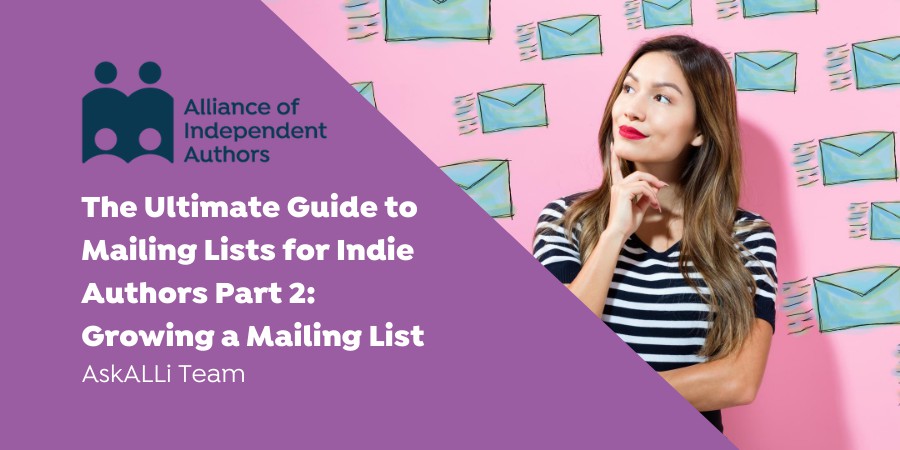In a three-part series starting two weeks ago, the Alliance of Independent Authors #AskALLi team has been exploring mailing lists, how to set them up, how to grow them, and today, how to maintain them and sustain relationships and connections with your readers. With deep thanks to all of our members who contributed insightful comments and a special thanks today to Elise Noble. This is the ultimate guide to mailing lists for indie authors part 3: maintaining and expanding your email lists.
See part one here: The Ultimate Guide to Mailing Lists for Authors Part 1: Mailing List Strategy. See part two here: The Ultimate Guide to Mailing Lists for Authors Part 2: Growing a Reader Mailing List
Maintaining a Reader Mailing List: Why Bother?
Once you've built your list, why bother maintaining it? Surely you've done the hard work? You've connected with readers, you've regularly sent them email, what more do you need to do? Not so fast, there's still a few important tasks you need to complete to maintain the health of your mailing list.
Once you have a mailing list, it's important you optimize it. That means even if your autoresponders are evergreen, they may need a touch up. Have you grown your business or services? You'll want to add those to your autoresponders, maybe your voice has changed and you could polish the prose in your emails. Have you started a new series and therefore does it make sense to separate out your readership?
More than that, it's about you taking a moment to step back and assess what you're doing. Are you still engaging your readers? Are your open rates still high? Do you know for certain you're still sending out the type of content your mailing list like?
And what about you, the author? Are you happy with the frequency you're emailing. Would you like to do more, less? This is your business remember, and much as it's important to deliver what your audience wants, it's also important that you're still deriving joy from your work too.
Why bother? Because putting in the work to review, prune, and optimize your list will ensure that your list stays healthy and your connection with your readers strong.
Maintaining an Email Marketing List: Data
Don't groan. Data doesn't have to be difficult. There's plenty of options for capturing data with your mailing list. First of all, you have a range of data and metrics at your disposal every time you email your list. Dig into the stats and review your click rate, how many times your emails have been opened. Compare that data to other emails you've sent. Did one get a surprising spike? Analyze why you think that might be.
Split Testing
Another fantastic option for improving your mailing list management is to run split tests. What's a split test? It's where you cut your mailing list in two (or more sections if you want to test more options) but you'll have bigger groups and therefore sample sizes if you just split your list in two. Then you send them identical emails with the exception of one change. What sort of things could you change? Here's a list of ideas:
- Subject lines
- Including a banner or not
- Including images or not
- Including first names or not
- hyperlinks versus “buy buttons”
- Call to Action lines “buy now” “read more” “find out more”
- Wording changes
- Color changes
Maintaining a Reader Mailing List: Increase Open Rates and Clicks
The higher your open rate (i.e. the number of people opening your emails) the better your credibility is with email providers—meaning more of your emails will end up in your reader's inboxes rather than their spam folders.
Once you've built (and are continuing to build) your list, it's time to boost your open rates here are some quick tips for doing that.
- Spice up your subject lines. If your open rates drop, examine your subject lines. Are you asking questions, are they thought provoking or enticing? It's a good time to read up on copywriting. Sure, no one wants to use clickbait type subject lines, but remember, you don't have to write your whole email that way. All you're doing is trying to get them to open the email in the first place.
- Examine and refresh your autoresponder sequence. It's the first time your emails are dropping into their inbox, so they're most likely to open them to see what you have in store. If your rates aren't high, then look at what you can do differently, how can you add more value?
- While you're updating your autoresponder, make sure you add in whitelist instructions so that more of your emails automatically pass your reader's spam filters.
- Make sure you actually email your list, and regularly. You can determine that regularity, but if you've promised content, make sure you're giving it to them.
- Include something for your subscribers to click on in each email. Having a high click rate means your credibility as an emailer is increased. That doesn't mean you need to include a “buy now” link. It could be a link to a play list that inspired a scene, or to a digital mood board about one of your books. Or perhaps a link to an article about your characters or to an article they may find useful. Whatever you put in, getting those clicks will help increase your delivery rates in subsequent emails.
Maintaining a Reader Mailing List: Deliverability Rates and The Prune
If you haven't heard of the term “pruning your mailing list” then it means deleting and cutting inactive subscribers. Before you gasp, there's a good reason for doing it.
If your list has 1000 subscribers, but only 600 of them are active and the other 400 haven't opened an email in 6 months, then the chances are, those 400 subs aren't going to open any of your other emails either. Why would you pay good money to host their email address when they're unlikely to engage with you or your books? Cut them and save yourself some money, it makes good business sense.
Now, of course, it's not always as simple as that. Mailing list data is notoriously unreliable. So, you will always carry some measure of risk that you'll delete someone that could have been an engaged subscriber. But data is getting better and there are some mechanisms you can put in place to prevent that.
First of all, you need to group (or segment as mailing list providers often call it) your email list. Group by subscribers who haven't opened your emails in a certain number of months—you can decide how many. Then email that segmented group a specific message. For example, you can have a punchy subject line like: Shall I Go Away? In the body of the email and then explain what you're doing. Here's an example email:
Hi XXX,
I'm just dropping a quick note to ask if you'd still like to receive emails from me. My email provider tells me you haven't opened my emails for a while. That's cool, no hard feelings, we all get busy.
I'm going to remove inactive members in [insert time period], as the mailing list is expensive to maintain and I have to pay per member.
I know that computers can get these things wrong, and sometimes opens don't register. If you want to stay on my list, please click the big blue button below.
[insert a big blue button here]
If you'd rather I didn't email you any more, that's absolutely fine too. You don't need to do anything — I'll automatically stop emailing you by the end of January.
All the best,
Once you've sent that email to the segmented list, wait a week to see what the numbers are like. Move anyone who did click into your normal mailing list. Then delete anyone who didn't open or didn't click. And voila, you have a pruned list.
After you've pruned you should see your open rates increase as the people left on your list will be your most engaged subscribers.
Segmenting your Reader Mailing List
As you grow as an author, your email offerings and lists will grow with you. Most advice about email lists for authors assumes that we write in only one niche. Life is certainly simpler when we do but many authors write across a number of genres.
And many of those who write in one genre have different series that may not crossover. Each of these needs a separate subscriber list.
The word “list” implies that you handle different groups of subscribers completely separately, but most email providers now offer the option to filter and segment a single list of subscribers, based on chosen criteria. For authors that might be different author names, different genres or different series.
Segmentation allows you to send highly targeted emails, based on the specific characteristics that differentiate each of your reader groups. You can tailor the content of your marketing campaigns to each individual segment, which significantly increases your conversions and sales. It's the difference between how a shotgun and a sniper rifle operate, says OptinMonster in this post that offers 50 Segmentation Tips: “The former blasts away broadly and blindly hopes a few of the pellets hit. The latter tracks, targets, and precisely hits its target.”
Every author's books and business is different, so how you segment your email list will also be unique to you but everyone needs three things to segment an email list effectively:
However, there are two essentials needed in order to segment your list properly and effectively:
- An email service provider that allows segmentation and landing pages (See Part 2 of this series for more on good services)
- Reader Magnets: These are offerings that attract the right readers, allow them to self-identify as the right reader for a particular segment's communications. OptinMonster has a huge list of lead magnet ideas here.
The AskALLi team's advice would be to learn to manage one list well before segmenting
Segmenting Your Email Lists: Case Study, Orna Ross

Orna Ross, Director of ALLi
I've always known the value of a mailing list and had a list since I started blogging back in 2008. Good for me! Unfortunately, apart from that, I got everything wrong. For years, I had one list. One list! Even though my books are not just in three different genres, but three different macro-genres of fiction, non-fiction and poetry! Wrong, wrong, wrong.
I write guides for authors and creatives, historical novels, and inspirational poetry, which clearly have three very different readerships. I cringe now at how annoying it must have been for my fiction readers to get my musings on self-publishing and my indie author followers to be subjected to my poetry. It's a wonder they didn't all unsubscribe.
Add to that muddle a tendency to communicate none too often and my email strategy was a hot mess. I got followers but by luck rather than process. And I always carried a feeling of anxiety about my email marketing.
Now I can see that having such a diverse group diluted the content of my mails and also made me less likely to send them. I was vague about what I should be sending. I would dither and doubt what I was sending, especially if it related to fiction and poetry. I knew the value of the hard self-publishing information and that got sent out religiously. It was harder for me to believe in the what I was offering in my novels and poetry books, and those were harder emails to craft.
I have now separated my lists into four segments:
- Fiction
- Poetry
- Go Creative! author-business planning
- Self-publishing
What readers receive from me under those headings needed to be broken down further. I have two poetry lists, for example.
-
- a list for readers who love inspirational poetry
- a list for poets who want to submit to my discoverability hashtag for indie poets, #indiepoetryplease
Two non-fiction lists:
-
- a list for those interested in self-publishing, who receive a round-up of the ALLi blog each week (selfpub) and another list for those who want podcast alerts
- a list for those who are interested in my monthly creative business planning membership and workshops (Go Creative! in Business)
Two fiction lists:
-
- a list for my novel readers, a serialization of my work–in-progress, drawing on the social media updates I've done on Facebook that month. Those who follow this list receive a chapter or two of my first draft each fortnight–and I invite comments and suggestions about what should happen next.
- a list for my reader members, who receive free books, advance review copies and other bonuses
Seven different kinds of readers, receiving very different emails from me.
Oh and I also have a Patreon page for poets and poetry lovers, where I also offer a small-group membership for my authors and poets who want to improve income and impact. And a Facebook accountability group for those authors and poets too.
Does it look horrendously time-consuming? My experience has been the opposite.
Since I started working this way, my newsletters take me less time to write, and most importantly (see above) they actually get written. It's because the process is now clear for each group. I know exactly who I am talking to, what I'd like to say to them, what I think they'd like to hear from me.
The emails are now fun to write and I look forward to reader responses very much.
Though I did get everything wrong from the start, I did the most important thing. I got my list started. Takeaway 1: Creativity is messy. You can get it wrong while also getting it part right. Just get started and keep going. Takeaway 2: Don't be daunted if you are a multi-genre author, lots of us are.
Today's tools allow you to segment and grow a number of different audiences. Get one list right first, then over time, you can expand your offerings.
Refining Your Email List: Case Study Sacha Black

ALLi conference and blog manager, Sacha Black
I do not profess to be a mailing list expert, but what I do know, is that when I came to review my mailing list last month, I realized it was way out of date. I'd had a couple of readers email me picking up some out of date content. Which prompted the review where I also found the podcast I've been running for a year wasn't mentioned in my autoresponder sequence. So I knew it was time to polish and refine my system. It's prompted a move to a new mailing list host, so I'm rolling the autoresponder refresh in as part of it.
What Goes Out of Date?
I made a school boy error. I mentioned a date in my sequence. At the time of creating them, I had an upcoming release and foolishly mentioned the year… it was 2017… and yes, in 2020, that email was still being sent out. If you don't have time to keep updating your sequence, avoid dates altogether, it ages your sequence very quickly. But if you avoid dates, seasons, or time in anyway shape or form, then your sequence stays evergreen.
Holistic Approach for a Holistic Business
My original autoresponder sequence focused on one book. But by the end of this year, I'll have 11. Which means I'm missing out on introducing new subscribers to all my other books. While each of those books might not be new to Amazon, as Joseph said last week, they will be new to my subscribers, so I'll be creating an extended autoresponder sequence to ensure all my books are covered. I'll be taking one topic from each of my books to cover in a set of tutorial emails so that they all get “air” time in the autoresponder. I also have services for authors—again, none of which were mentioned in my autoresponder sequence.
Voice Refresh
For most indie authors, as we continue our journeys in the writing world, we continue to grow, learn and develop. While the core of my “voice” was in my emails, there was a certain finesse missing. A tweaking that's happened over the years as I've grown as a writer. I noticed clunky sentences, words I wouldn't necessarily choose now.
As my emails are part of my author funnel and branding, it's important they accurately represent me and the “feel” that readers will get across my books.
Technology Refresh
Video and audio consumption is increasing year on year. I wanted to make my emails more inclusive to readers. While I can't create video and audio for all my emails, I can do it for my autoresponders. So I've filmed the tutorials in my autoresponders and loaded them to YouTube and linked them into my emails. I also felt this better matched the direction I'm taking my business, which is to create video courses.
Playing with Data
I hate data. Like truly, I am not a numbers girl. But what I do appreciate, is what the numbers can tell me. I examined the open rates for each of the emails in my autoresponder and one email in particular had a lower open rate—20% lower. This tells me that either the subject line was no good as it wasn't enticing people to open, or the topic didn't work. Either way, it's one that needs a tweak to try and boost those open rates. I'll be watching that email as I roll out the new sequence to see how it performs.
Maintaining an Email Marketing List: Member Experiences
Elise Noble

Elise Noble
“Most of my mailing list subscribers sign up via the back of my books. I often write a short story or some bonus chapters that go with the story, and readers can sign up to receive them via an automated sequence. I also have a sign-up form on my website and get a fair few people from there too. The most engaged readers come from my Facebook group rather than my mailing list. I have a link to the group in every newsletter.
I usually have a bit of chat at the beginning of each newsletter, letting readers know what I've been up to and sometimes updating them on my animals (Trev the horse is a favourite). If I've got a new release or a pre-order or a sale, I tell them about it. Plus I serialise a novel in my newsletters – one or two chapters each fortnight – and readers vote on what they want to happen next :)”





Great post. Regarding pruning, I’ve learned something recently about open rates. Often, the recipient can PREVIEW the email, which doesn’t record as an open. There could be a group of people who are enjoying your newsletters but don’t appear to be engaging. I always include links to other content to see if I can get a better sense of what’s happening by tracking clicks.